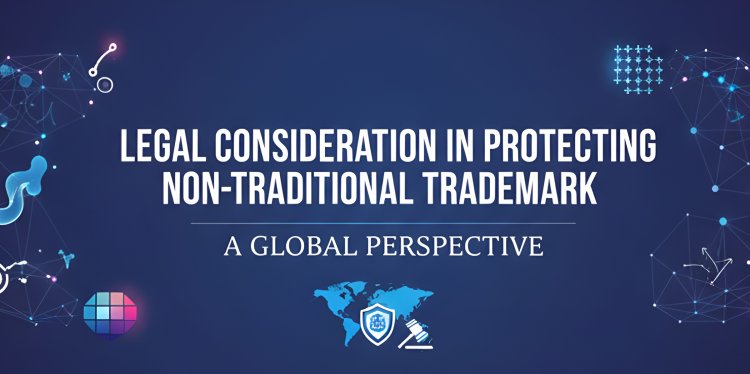LEGAL CONSIDERATION IN PROTECTING NON-TRADITIONAL TRADEMARK: A GLOBAL PERSPECTIVE
This blog provides a comprehensive study on non-traditional trademark, a dynamics field in the intellectual property law landscape that goes beyond typical word and logo marks to encompass sensory and three-dimensional indication like sound, color, shape, scent and motion. Non-traditional trademarks bring certain complexities that arise because they are not just logos. The blog analyses in depth the legislative laws, judicial precedents, and administrative policies of non-conventional marks in countries like India, the United States of America, and the European union. comparative analysis undertaken in the paper will discuss the obstacles presented to the applicants and trademark offices to register and enforce rights in these categories of mark together with landmark cases that have influenced the jurisprudence in both jurisdictions. The paper concludes by proposing recommendation for reform in India, aimed at harmonizing its trademark regime with international best practices, thereby

INTRODUCTION
A trademark primarily functions to indicate the origin of goods or services, but it has been agreed that those functions have expanded to include advertising and investment in modern society. Traditionally, trademarks consisted of words, logos, or graphic design which were added to goods or packaging. By way of contemporary legal development, this has expanded to include non-traditional trademark such as colour, shapes, sounds, smells, video clips, holograms, and gesture. This article provides a brief background regarding the principles and origins of trademarks and outlines key frameworks of trademark law in order to examine and evaluate the protection of non-traditional trademarks, utilising their commercial value as an example of why they should be protected. While NTMs offer unique marketing advantages, their protection raises complex legal challenges. Issues such as distinctiveness, representation, functionality, and enforcement vary across jurisdiction, making international protection difficult. With globalization and digital commerce on the rise, understanding the legal consideration surrounding NTMs from a global perspective has become more important than ever.
LEGAL BACKGROUND
The protection of trademarks is rooted in both national legislation and international agreements. Traditionally, trademark laws were designed for conventional marks words, names, logos, and symbols. However, as businesses began adopting non-traditional trademarks (NTMs) like colors, sounds, shapes, and scents, legal system had to evolve to address their registrability and enforcement.
At the international level, the Paris convention (1883) established the principle of protecting industrial property, including trademarks, across member countries. Later, the TRIPS Agreement (1995) broadened the definition of a trademark to include “any sign…. capable of distinguishing” goods or services, thereby laying a foundation for NTMs, although recognition of NTMs still depends on individual national law.
GRAPHICAL REPRESENTATION
One of the primary challenges is registering non-conventional trademarks is the requirement for graphical representation. This becomes particularly problematic for sensory marks like scents, tastes, and textures which do not easily translate into standard visuals. for example, while sounds marks can be represented using musical notation, represented something intangible like smell or a texture that meets the legal criteria is much more difficult. This changed with the case of Ralf Sieckmann v DEUTSCHES PATENT-UND MARKENAMT where it was held that a non-visual mark could be registered if it could be graphically depicted. This case established important criteria regarding what constitute a sign: that it be clear, precise, self-contained, easily accessible, intelligible, durable, and objective. These requirements are known as the SIECKMANN CRITERIA.
Here is a detailed breakdown of the legal considerations in protecting non-traditional trademarks from a global perspective, based on current research:
Core Legal Challenges for Non-Traditional Trademark
The primary legal hurdles for NTMs stem from their intangible nature and the historical focus of trademark law on visual representation.
A. The Requirement for Representation (The Sieckmann Criteria)
Global Standard: Historically, most jurisdictions required a graphic representation of a mark. This is highly challenging for marks based on sound, scent, or texture.
The Seickmann Test (EU Origin): This landmark European court of justice case established that for a non-traditional sign to be registrable, its representation must be clear, precise, self-contained, easily accessible, intelligible, durable, and objective.
Impact: This test effectively blocked the registration of most scent marks in the EU for a long time, as a chemical formula (often used as a representation) is not easily “intelligible” to the average consumer.
Modern Shift: Many jurisdiction (including the EU post – 2017) have moved away from the strict graphical representation requirement and now allow digital file submission ((e.g., sound clips, video files, or detailed descriptions) to satisfy the clarity and objectivity criteria.)
B. Proving Distinctiveness and Secondary Meaning
Inherent lack of distinctiveness: Unlike an arbitrary wordmark, NTMs (especially colors, scents, and sounds) are rarely considered inherently distinctive. A color, for instances, is merely a decorative element unless proven otherwise. Acquired Distinctiveness (secondary meaning): Protection for NTMs almost always hinges on the applicant proving acquired distinctiveness- that the mark, through extensive or continuous use, has come to be recognized by the consuming public as a source identifier for the goods/services.
C. Legal Uncertainty
Laws in many countries including India, lack clear guidelines for non-traditional marks, leading to inconsistent rulings.
Conclusion
The future of trademark law must embrace a purpose-driven, open-ended approach recognizing non-traditional signs as legitimate, enforceable indicators of commercial origin. By balancing innovation incentives with fair competition and practical enforceability, NTTs form a cornerstone of global intellectual property strategy.












